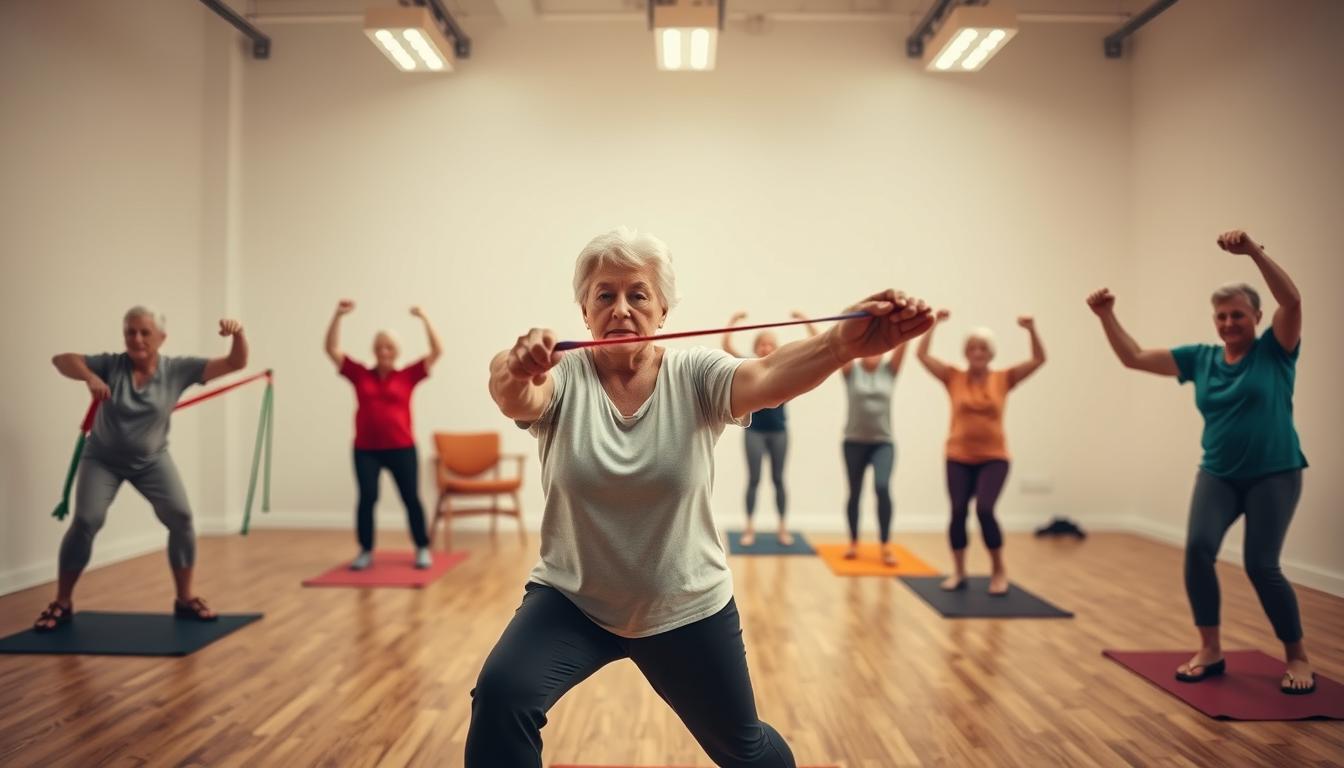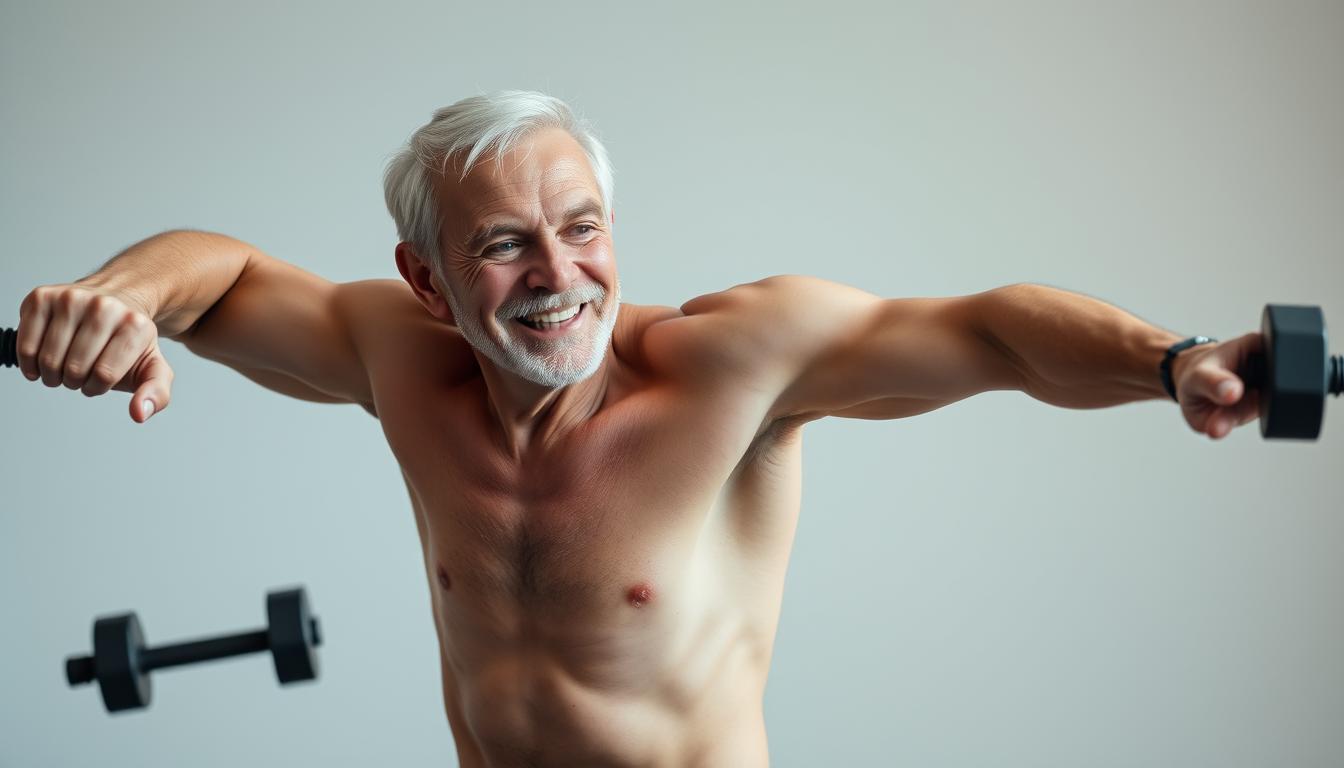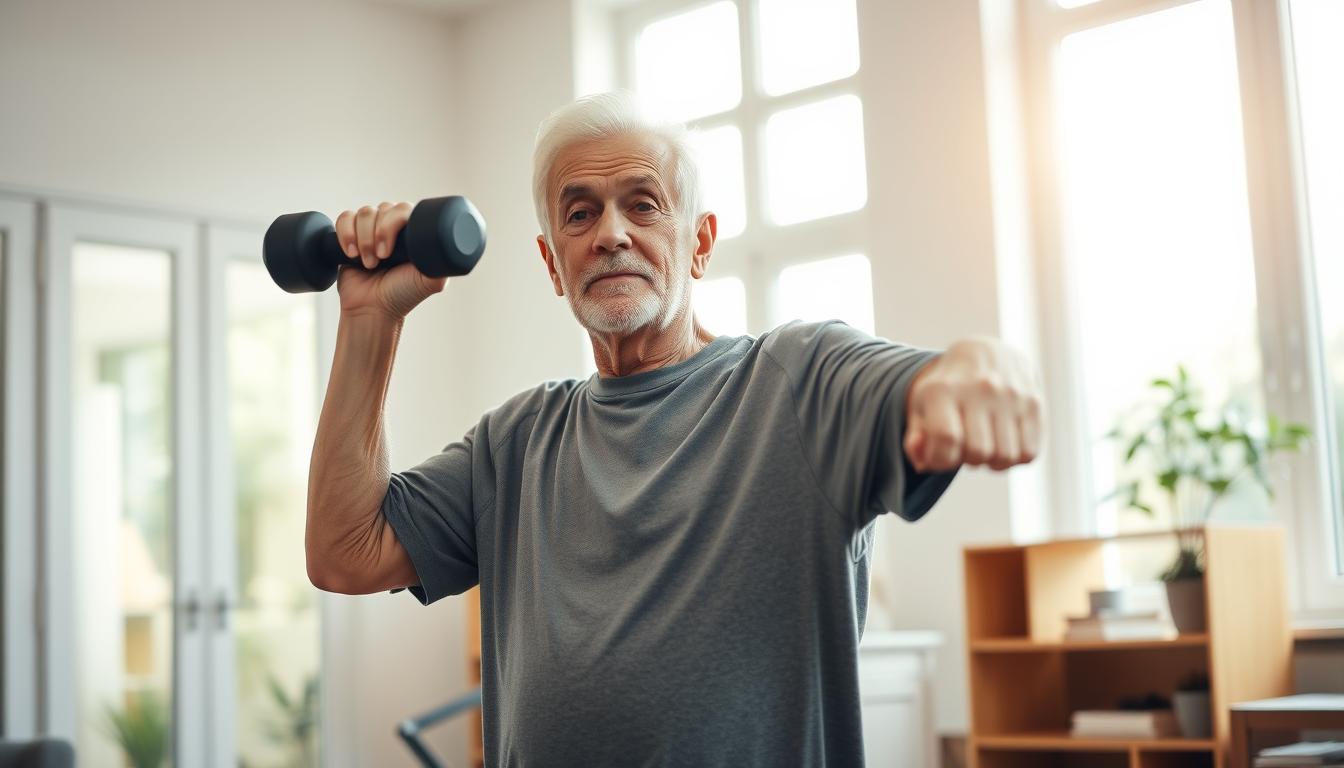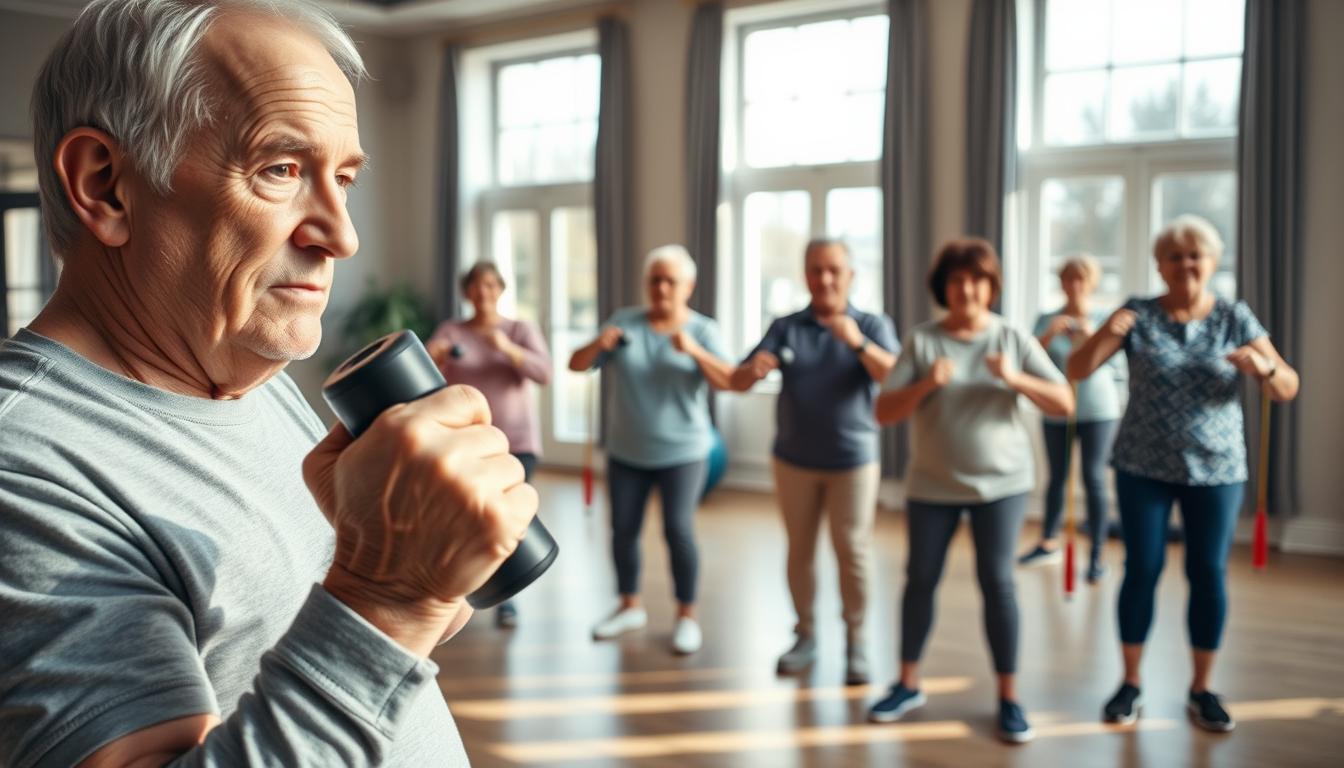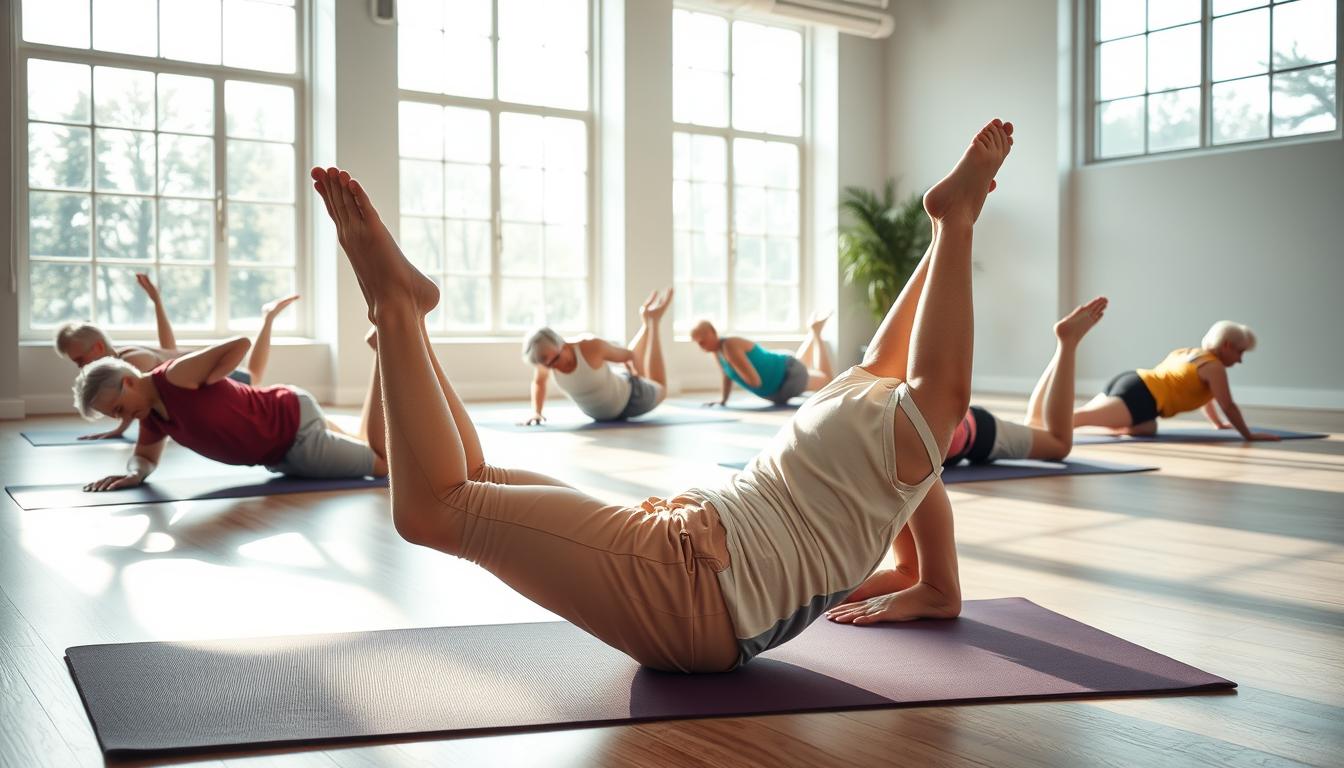Let’s cut to the chase: You don’t need heavy weights or a gym membership to stay strong after 60. I’ve seen folks in their 70s out-lift younger gym rats using nothing but a $15 stretchy loop—seriously, these things are like rubbery magic wands for your muscles.
David Jack, a trainer who works with older adults, calls resistance bands “the Swiss Army knife of fitness tools.” Why? They’re gentle on creaky joints but tough enough to make your biceps whisper “oh, we’re working today.” Plus, you can stash ’em in a drawer next to your TV remotes—no fancy equipment required.
Here’s what I love: Whether you’re recovering from surgery or just hate floor exercises, there’s a modification for you. We’ll cover moves you can do while parked in your favorite recliner and standing variations using a kitchen counter for balance. (Pro tip: That soup can collection doubles as light weights in a pinch.)
I’ve road-tested these routines with my 68-year-old neighbor who swears by her “band time” during morning coffee breaks. Her secret? Starting with just 8 minutes a day. By the end of this guide, you’ll know exactly how to:
- Turn laundry day into leg day using door anchors
- Boost grip strength while watching Jeopardy!
- Progress safely without feeling like you’ve been hit by a truck tomorrow
No fluff. No jargon. Just seven moves that actually work with your body—not against it. Ready to make your grandkids jealous of your arm strength?
Understanding Resistance Bands and Their Role in Senior Fitness
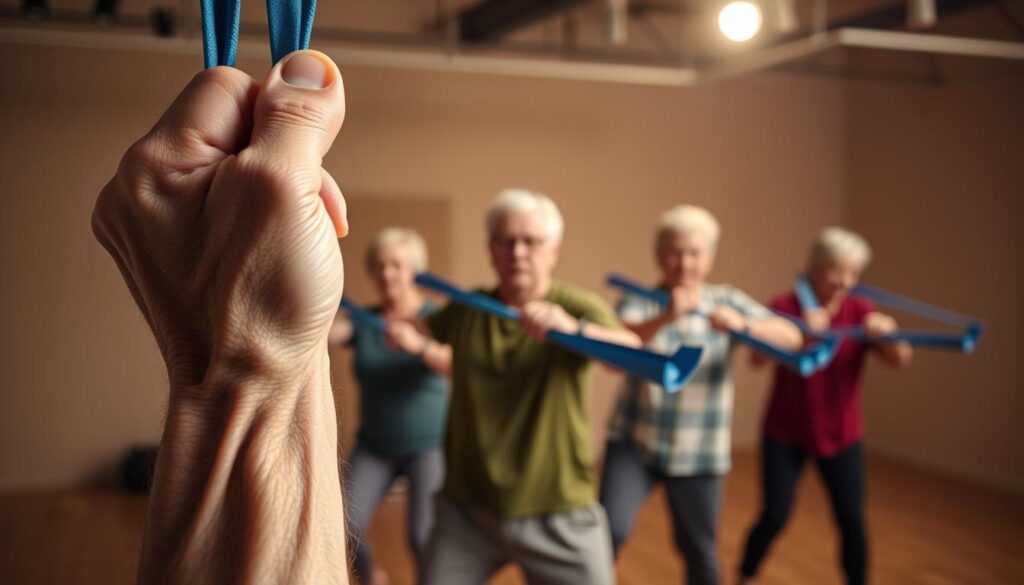
Picture this: A tool that adapts to your strength level, workout after workout. Unlike clunky dumbbells that force your muscles to lift fixed weights, stretchy loops create variable resistance—meaning the tension increases as you pull harder. It’s like having a personal trainer who adjusts the challenge mid-rep.
Real-world benefits without overhyping
These elastic tools aren’t magic, but they’re close. A 2022 study by the American Council on Exercise found users activate 27% more muscle fibers during banded exercises versus traditional weights. Why? Your body fights tension that grows as the band stretches—like pulling back a bowstring.
For older adults, this means:
- Safer joint movement (no sudden drops if you lose grip)
- Customizable intensity (lighter or heavier with a simple band swap)
- Better balance training (standing moves engage stabilizer muscles)
How varied tension boosts muscle engagement
Here’s the kicker: Bands force muscles to work harder at their strongest angles. Try a seated bicep curl. The band slackens when your arm is down, then fights you hardest at the peak contraction. Compare that to dumbbells, which feel heaviest at the start.
| Feature | Resistance Bands | Dumbbells |
|---|---|---|
| Portability | Fits in a pocket | Requires storage rack |
| Adjustability | Instantly change tension | Need multiple weights |
| Joint Impact | Low (smooth resistance) | High (sudden force) |
| Cost | $10-$30 | $100+ for set |
Physical therapist Dr. Lisa Hamilton notes: “Bands encourage what we call ‘neuromuscular adaptation’—your brain and muscles learn to work together differently each rep.” That’s why even simple moves feel fresh week after week. Up next: How to pick your first band without overwhelm.
Getting Started with Your Resistance Band—Tips and Tricks

Ever stared at a rack of stretchy loops wondering which one won’t launch itself across the room? Let’s fix that. Your first band should feel like a helpful workout buddy—not a wrestling opponent.
Match your stretch to your strength
Bands come in three main flavors: tube (with handles), loop (like giant rubber bands), and therapy (flat strips). New to this? Grab a light-to-medium loop style. They’re the Swiss Army knife of bands—great for seated and standing moves.
Here’s my go-to test: Hold the band with both hands at chest height. If you can stretch it halfway without straining, you’re golden. Too easy? Layer two bands. I’ve seen newbies grab the heaviest option and regret it by rep three—start light to nail your form.
Check the ends before each session. Frayed edges or thin spots? Retire that warrior. Most last 6-12 months with regular use. Unsure? Ask a trainer at your local YMCA or SilverSneakers class. They’ll spot-check your grip and suggest upgrades when you’re ready.
Remember: This isn’t a competition. That purple “beginner” band? It’s your ticket to consistent progress. Think of it like learning guitar—master the chords before shredding solos.
Resistance Band Exercises for Seniors
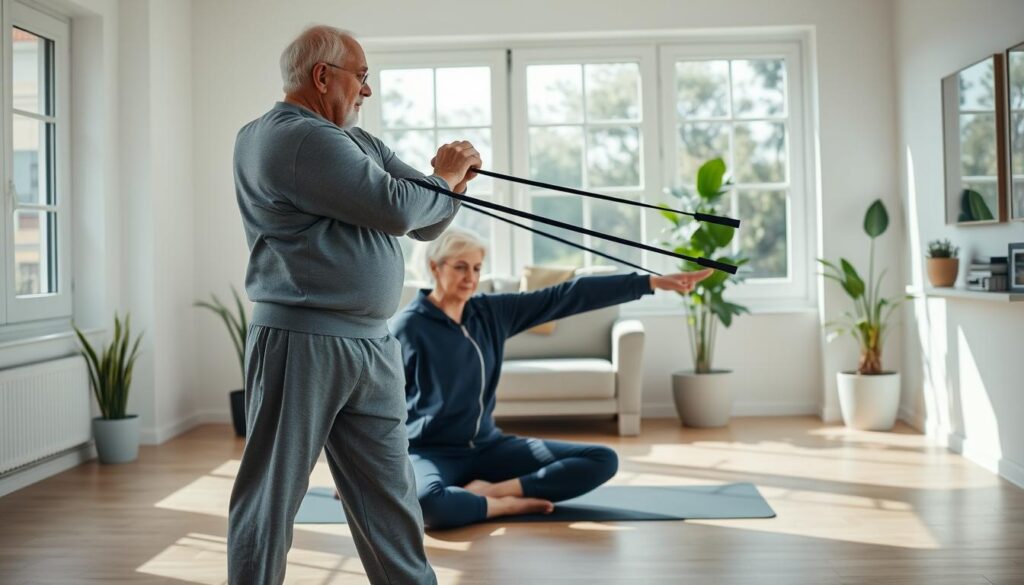
Let me show you how to transform any space into a workout zone—no gym bag required. Seated and standing moves work magic at home because they adapt to your environment. SilverSneakers instructors swear by this approach: “Start where you’re most stable,” they say. “A sturdy chair becomes your workout partner.”
Smart setups for creaky knees and tired hips
Try this chair-based row: Sit tall, loop the band under your feet. Grab the ends, pull elbows back like you’re starting a lawnmower. Slowly release—that’s your return starting position. Do 10 reps. Feel your shoulder blades wake up? That’s the ticket.
For lower body power, the seated leg press kills two birds: strengthens quads and improves balance. Anchor the band to a table leg. Loop the other end around your foot. Push forward slowly, then ease back. No jerking—control is key.
| Move | Seated Benefits | Standing Benefits |
|---|---|---|
| Rows | Supports spine | Engages core |
| Leg Press | Reduces knee strain | Boosts ankle stability |
| Overhead Press | Prevents dizziness | Improves posture |
Low-impact tweaks that pack a punch
Standing moves? Keep one hand on the kitchen counter. Try side steps with the band above your knees—tiny movements, big results. Public health guidelines recommend 2-second pauses at peak tension. Why? It teaches muscles to hold strength, not just move through it.
Remember: Ending each rep in your return starting position isn’t just safe—it builds muscle memory. My 72-year-old yoga buddy does these while waiting for her tea kettle. “Eight minutes,” she laughs. “That’s all it takes to feel 10 years younger.”
Step-by-Step Guide to Chair and Standing Workouts
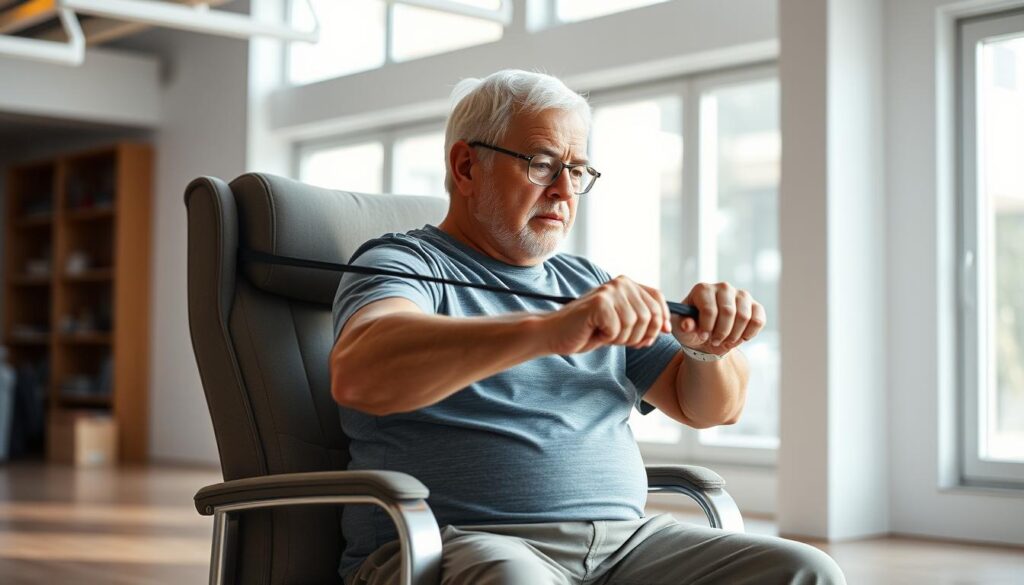
You know that sturdy dining chair collecting dust? Let’s turn it into your new fitness partner. I’ve helped dozens of folks use household items to build strength—no gym required. The secret? Treat every move like a slow dance with the band, not a race.
Chair Rows That Wake Up Your Back
- Sit tall with feet flat (like you’re balancing a book on your head)
- Loop the band under both feet—palms facing each other
- Pull elbows back slowly, squeezing shoulder blades (imagine cracking a walnut between them)
- Hold for 2 breaths, then return to starting position with arms straight
Aim for 8-10 reps. My buddy Jim does these during commercial breaks—he’s up to three sets without missing Wheel of Fortune.
Leg Presses That Protect Your Knees
- Anchor the band to a table leg (test it first—no flying furniture!)
- Loop the other end around your right foot
- Push forward like you’re mashing potatoes, keeping toes up
- Pause when legs are almost straight, then ease back
Keep both feet planted firmly. Physical therapist tip: “If the band feels too light, pause longer at full extension instead of speeding up.”
| Move | Chair Version | Standing Version |
|---|---|---|
| Row | Supports lower back | Engages core muscles |
| Leg Press | Reduces joint impact | Improves balance |
| Overhead Press | Prevents dizziness | Builds shoulder stability |
Last week, a client told me she rushed her reps and the band slipped. Lesson learned: Quality beats speed every time. Always check your starting position—those first inches set the tone for the whole movement. Now go show that chair who’s boss!
Targeting Specific Muscle Groups with Focused Moves
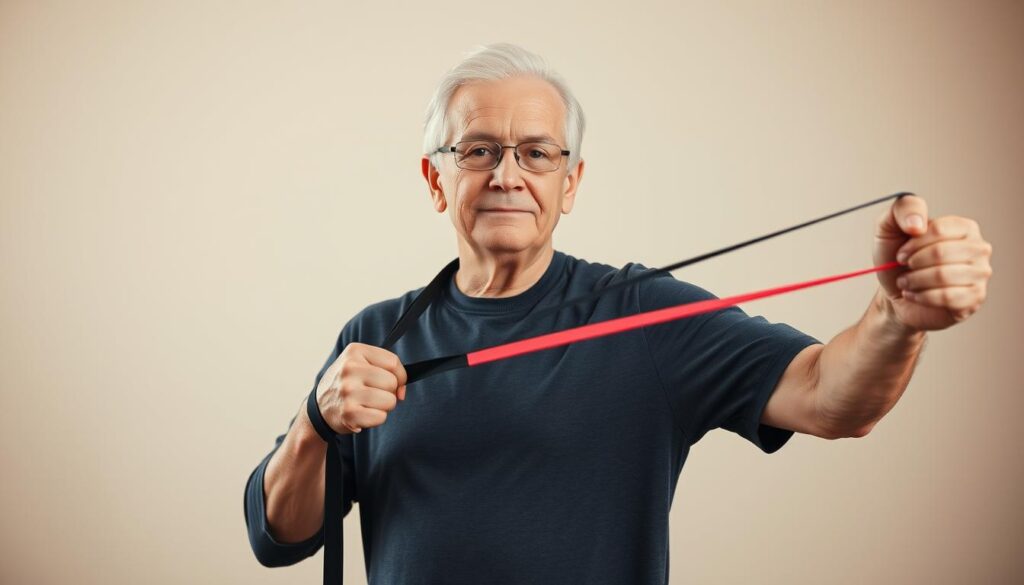
Think of your muscles as a team—each player needs attention to win the game. That’s why smart training focuses on core stability while working arms, legs, and everything in between. I once helped a neighbor rediscover her golf swing by zeroing in on three key areas: her midsection, shoulders, and hips.
Engaging the core, upper body, and lower body
Your trunk muscles aren’t just for looks—they’re your body’s natural weight belt. Try this: Sit tall and loop a band around your thighs. Push knees outward while pulling the band taut. Feel that burn? You’re activating hip muscles and challenging your core simultaneously.
For upper body power, focus on moves that connect shoulder blades to arm movements. A proper row isn’t about yanking elbows back—it’s about squeezing those blade bones like you’re holding a pencil between them. This protects rotator cuffs while building back strength.
| Area | Key Moves | Daily Life Benefit |
|---|---|---|
| Core | Seated twists | Easier bed transfers |
| Arms | Overhead presses | Carrying groceries |
| Legs | Side steps | Stair climbing |
Balancing resistance to keep joints safe
Here’s where stretchy loops shine: They let you dial intensity up or down mid-move. Starting a bicep curl? Light tension. At the peak? Maximum challenge. This gradual load protects elbows better than sudden weight shifts from dumbbells.
Always keep one stable point—like a chair arm or countertop—when trying new moves. My golden rule: If you can’t hum a tune while exercising, you’re pushing too hard. Balance isn’t just physical; it’s about respecting your body’s current limits while gently expanding them.
Staying Safe: Warm-Up, Posture, and Smart Movements
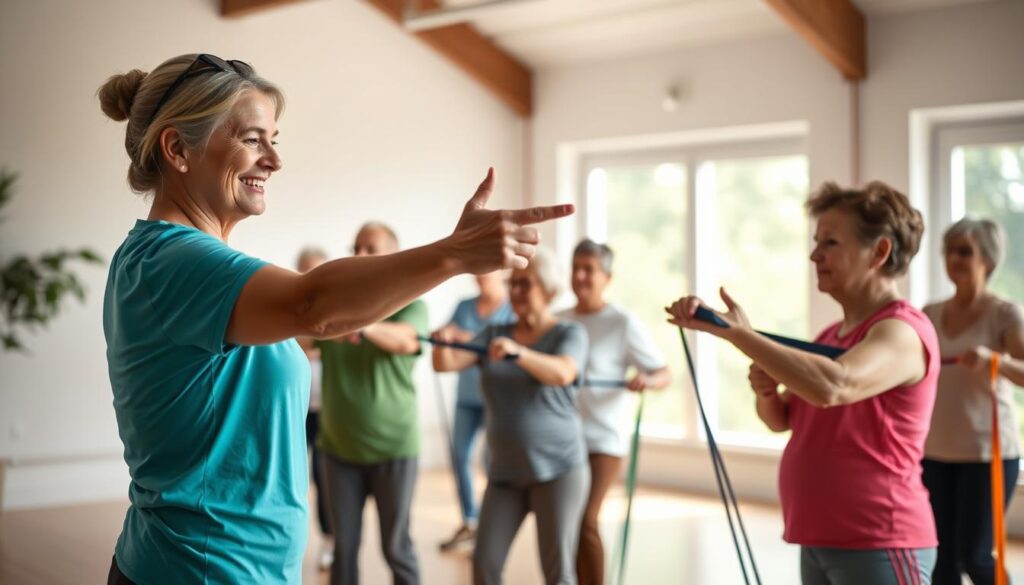
Here’s a truth bomb from my early training days: Skipping your prep work is like pouring coffee grounds directly down your throat—it gets the job done, but ouch. Public health guidelines agree: A proper routine reduces injury risk by 34% compared to jumping straight into workouts. Let’s make your warm-up as enjoyable as that first sip of morning joe.
Simple warmup routines to get blood flowing
Start with this 3-minute movement cocktail I’ve used with clients for years:
- March in place while brushing teeth (30 seconds)
- Shift weight from foot to foot like a slow-motion dance
- Circle both elbows forward/backward—pretend you’re drawing lassos
This isn’t about breaking a sweat. It’s waking up your joints and tendons. Physical therapists call it “greasing the groove”—prepping your body for action without shock therapy.
| With Warm-Up | Without Warm-Up |
|---|---|
| Gradual heart rate increase | Sudden blood pressure spike |
| Improved muscle elasticity | Higher risk of microtears |
| Better mind-body connection | Awkward, jerky movements |
Keep those elbows soft during stretches—no chicken-wing flapping. Posture tip: Imagine a string pulling your head toward the ceiling. My neighbor Edna pairs this with her favorite big band playlist. “Two songs,” she says. “That’s all it takes to feel limber enough to tackle the grandkids.”
Remember: Your routine should feel like stretching fresh-baked bread dough—gentle, purposeful, and oddly satisfying. Now let’s turn that warm buzz into workout magic!
Integrating Tech: Tracking Progress with Modern Resistance Bands
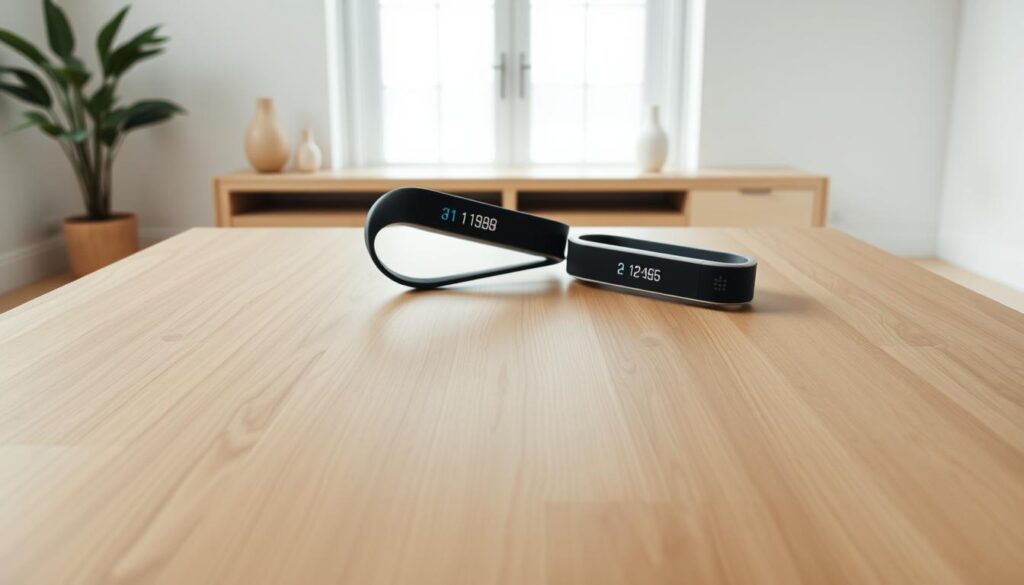
Remember when your wristwatch just told time? Today’s stretchy workout tools are getting the same tech upgrade. I recently tested bands that talk to your phone—not literally, but close. The LIT Axis models with built-in sensors made me rethink how we measure progress after 60.
How sensors turn guesswork into growth
These aren’t your grandkid’s rubber loops. The LIT Axis tracks every pull and release like a fitness detective. During my trial, the app showed:
- Real-time “weight” adjustments (no math required)
- Seconds your muscles spent under tension
- Whether your hands drifted from proper palms facing position
One client joked it’s like having a coach who never naps. The band’s secret? Tiny sensors measure stretch length 200 times per second. Too easy? The app suggests firmer resistance. Struggling? It auto-adjusts your next set.
Here’s why I’m hooked: After three exercise sessions, you get a progress chart showing strength gains in specific muscle groups. My 71-year-old test group loved the “nudge reminders” to check their grip—no more white-knuckling the band.
Best part? You’re not glued to screens. Review stats post-workout while sipping tea. As Martha from my walking group put it: “Finally, tech that works with me, not against my creaky joints.”
Wrapping It All—Smart, Sustainable Strength Building that Evolves…
Here’s the beautiful part: Your strength journey doesn’t end here—it evolves as you do. Those stretchy loops? They’re not just tools; they’re partners in crime for lifelong fitness. From nailing your starting position to mastering that smooth return starting position, every rep builds smarter muscle memory.
Remember how we anchored bands to chairs? That’s the genius of home workouts—using what you’ve got to spark big changes. Keep those elbows soft during rows, palms facing inward for better grip. Control beats speed every time.
Tech lovers, rejoice: Smart bands now track progress without fuss. One client increased her workout duration by 40% using real-time feedback. But here’s the kicker—you don’t need gadgets to win. Consistency trumps complexity.
Final thought: Strength isn’t about lifting heavy—it’s about moving smart. Whether you’re doing seated presses or standing twists, honor your body’s pace. Your future self will high-five you for starting today… one controlled movement at a time.
